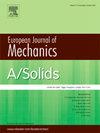三维固体大变形表面扩散的多物理场模拟
IF 4.4
2区 工程技术
Q1 MECHANICS
引用次数: 0
摘要
本研究提出了一个全面的理论和计算模型,探讨了在表面和体弹性以及表面扩散动力学的背景下,水合薄膜与非水合/不渗透软基材结合的行为。这种类型的耦合在光学干涉涂层、组织工程、软电子等各种工程过程中表现为一个不可或缺的方面,并且在下一代传感器和执行器的设计过程中非常重要,特别是当焦点转移到更小长度尺度的系统时。溶剂扩散和薄膜变形之间复杂的相互作用是由表面孔隙弹性和基材的粘弹性变形控制的。虽然现有的方法为研究涉及溶剂扩散和网络变形的耦合孔隙弹性提供了工具,但在理解附着在高度可变形固体边界的薄膜中发生的耦合孔隙弹性过程如何影响其响应方面存在空白。在本研究中,我们引入了一个包含表面孔隙弹性和体粘弹性多物理过程的非平衡热力学公式,并辅以相应的有限元实现。本研究对固体力学和计算建模做出了重大贡献,通过(i)模拟粘弹性衬底耦合的表面扩散,使研究对实际应用至关重要的时间相关响应成为可能;(ii)为具有不同参考(无应力)状态的两种材料(薄膜和衬底)的耦合提供了一个强大的理论框架,包括初始状态的详细解析推导。(iii)使用2D网格有效地对薄膜进行建模,以避免需要精细的3D实体网格,从而在保持精度的同时降低计算成本。这项工作提供了有价值的见解,特别是在表面扩散动力学和衬底弹性耦合是重要设计因素的情况下。本文章由计算机程序翻译,如有差异,请以英文原文为准。
Multiphysics modeling of surface diffusion coupled with large deformation in 3D solids
This study presents a comprehensive theoretical and computational model that explores the behavior of a thin hydrated film bonded to a non-hydrated/impermeable soft substrate in the context of surface and bulk elasticity coupled with surface diffusion kinetics. This type of coupling manifests as an integral aspect in diverse engineering processes encountered in optical interference coatings, tissue engineering, soft electronics, and can prove important in the design process for the next generation of sensors and actuators, especially as the focus is shifted to systems in smaller length scales. The intricate interplay between solvent diffusion and deformation of the film is governed by surface poroelasticity, and the viscoelastic deformation of the substrate. While existing methodologies offer tools for studying coupled poroelasticity involving solvent diffusion and network deformation, there exists a gap in understanding how coupled poroelastic processes occurring in a film attached to the boundary of a highly deformable solid can influence its response. In this study, we introduce a non-equilibrium thermodynamics formulation encompassing the multiphysical processes of surface poroelasticity and bulk viscoelasticity, complemented by a corresponding finite element implementation. This study makes significant contributions to solid mechanics and computational modeling by (i) modeling surface diffusion coupled with a viscoelastic substrate, enabling the study of time-dependent responses critical for practical applications, (ii) providing a robust theoretical framework for coupling two materials (film and substrate) with distinct reference (stress-free) states, including a detailed analytical derivation of the initial state, and (iii) efficiently modeling the thin film using a 2D mesh to avoid the need for a fine 3D solid mesh, thus reducing computational costs while maintaining accuracy. This work contributes valuable insights, particularly in scenarios where the coupling of surface diffusion kinetics and substrate elasticity is an important design factor.
求助全文
通过发布文献求助,成功后即可免费获取论文全文。
去求助
来源期刊
CiteScore
7.00
自引率
7.30%
发文量
275
审稿时长
48 days
期刊介绍:
The European Journal of Mechanics endash; A/Solids continues to publish articles in English in all areas of Solid Mechanics from the physical and mathematical basis to materials engineering, technological applications and methods of modern computational mechanics, both pure and applied research.

 求助内容:
求助内容: 应助结果提醒方式:
应助结果提醒方式:


